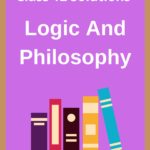Class 12 Logic and Philosophy MCQ Chapter 4 Mill’s Methods of Experimental Enquiry Question Answer English Medium to each chapter is provided in the list so that you can easily browse through different chapters Class 12 Logic and Philosophy MCQ Chapter 4 Mill’s Methods of Experimental Enquiry and select need one. AHSEC Class 12 Logic and Philosophy Objective Type Question Answer As Per AHSEC New Book Syllabus Download PDF. AHSEC Logic and Philosophy MCQ Class 12.
Class 12 Logic and Philosophy MCQ Chapter 4 Mill’s Methods of Experimental Enquiry
Also, you can read the NCERT book online in these sections Solutions by Expert Teachers as per Central Board of Secondary Education (CBSE) Book guidelines. AHSEC Class 12 Logic and Philosophy Multiple Choice Solutions are part of All Subject Solutions. Here we have given AHSEC Class 12 Logic and Philosophy MCQ in English Medium for All Chapters, You can practice these here.
Mill’s Methods of Experimental Enquiry
Chapter: 4
| MCQs |
Choose the Correct Option:
1. Which of the following is NOT one of Mill’s experimental methods?
(a) Method of Agreement.
(b) Method of Difference.
(c) Method of Residues.
(d) Method of Induction.
Ans: (d) Method of Induction.
2. What does the Method of Agreement focus on?
(a) Observing differences between instances.
(b) Identifying common circumstances in different instances.
(c) Studying the effects of known causes.
(d) None of the above.
Ans: (b) Identifying common circumstances in different instances.
3. What is a key feature of the Method of Difference?
(a) It compares two instances where the phenomenon occurs.
(b) It looks for common circumstances.
(c) It eliminates irrelevant circumstances.
(d) It compares instances where one has the phenomenon and the other does not.
Ans: (d) It compares instances where one has the phenomenon and the other does not.
4. The Method of Concomitant Variation focuses on:
(a) The relationship between cause and effect.
(b) The variation of two phenomena together.
(c) The absence of a cause.
(d) None of the above.
Ans: (b) The variation of two phenomena together.
5. Which method involves subtracting known causes from a complex event to find the remaining causes?
(a) Method of Agreement.
(b) Method of Difference.
(c) Method of Residues.
(d) Method of Concomitant Variation.
Ans: (c) Method of Residues.
6. The Joint Method of Agreement and Difference is a combination of which two methods?
(a) Method of Agreement and Method of Residues.
(b) Method of Agreement and Method of Concomitant Variation.
(c) Method of Agreement and Method of Difference.
(d) Method of Difference and Method of Residues.
Ans: (c) Method of Agreement and Method of Difference.
7. The Method of Agreement is a method of:
(a) Experiment.
(b) Observation.
(c) Deduction.
(d) None of the above.
Ans: (b) Observation.
8. Which method involves analyzing two instances where one has the phenomenon and one does not?
(a) Method of Agreement.
(b) Method of Difference.
(c) Joint Method of Agreement and Difference.
(d) Method of Concomitant Variation.
Ans: (b) Method of Difference.
9. In which method does the presence or absence of a phenomenon help determine its cause?
(a) Method of Concomitant Variation.
(b) Method of Agreement.
(c) Method of Residues.
(d) Method of Difference.
Ans: (d) Method of Difference.
10. Which of the following is a limitation of the Method of Agreement?
(a) Difficulty in finding common circumstances.
(b) Requires two sets of instances.
(c) It can only apply to one circumstance.
(d) All of the above.
Ans: (a) Difficulty in finding common circumstances.
11. Which method is best suited for finding causal connections involving permanent causes?
(a) Method of Concomitant Variation.
(b) Method of Residues.
(c) Method of Agreement.
(d) Method of Difference.
Ans: (a) Method of Concomitant Variation.
12. The Method of Residues is used to:
(a) Identify a single cause for an effect.
(b) Eliminate known causes to find the remaining causes.
(c) Study the relationship between variables.
(d) None of the above.
Ans: (b) Eliminate known causes to find the remaining causes.
13. Which of the following methods involves using experiments to collect instances?
(a) Method of Agreement.
(b) Method of Difference.
(c) Joint Method of Agreement and Difference.
(d) All of the above.
Ans: (d) All of the above.
14. What does the canon of Elimination in the Method of Agreement imply?
(a) If a circumstance is left out, it is not part of the cause.
(b) If a circumstance is left out, it is still part of the cause.
(c) If the cause is absent, the effect will still be present.
(d) None of the above.
Ans: (a) If a circumstance is left out, it is not part of the cause.
15. What is the key feature of the Method of Concomitant Variation?
(a) It studies qualitative aspects of variation.
(b) It focuses on the numerical relationship between cause and effect.
(c) It analyzes the presence or absence of a cause.
(d) None of the above.
Ans: (b) It focuses on the numerical relationship between cause and effect.

Hi! my Name is Parimal Roy. I have completed my Bachelor’s degree in Philosophy (B.A.) from Silapathar General College. Currently, I am working as an HR Manager at Dev Library. It is a website that provides study materials for students from Class 3 to 12, including SCERT and NCERT notes. It also offers resources for BA, B.Com, B.Sc, and Computer Science, along with postgraduate notes. Besides study materials, the website has novels, eBooks, health and finance articles, biographies, quotes, and more.


